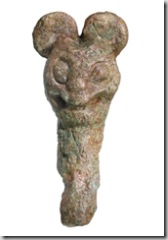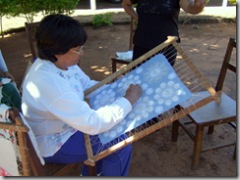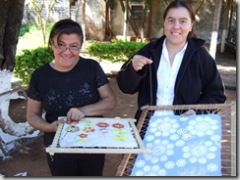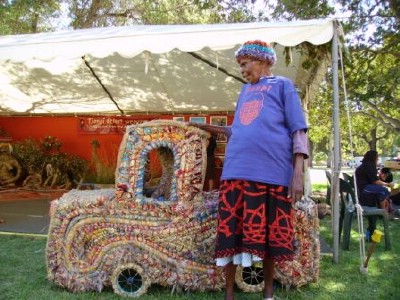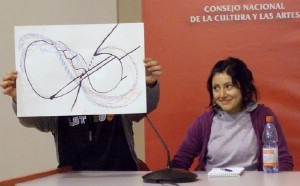Category Archives: Uncategorized
Ñanduti in Aregua
Under a shady tree, the women of Aregua produce a particular Paraguayan lace called ñanduti. This lace evolved from the influence of Tenerife lace, but has a more Guaraní emphasis on floral patterns. Below are images of two expert ñanduti makers, Osavia Yegros and lija Magdalena.
| Ñanduti literally means ‘spider web’. It is produced in quite intricate radial movements. The intricacy seems a general style of Paraguayan culture, almost like a courtly dance of the hand. For more on Paraguay, see here. |
Just imagine what kind of collaboration might be possible between these women and some of the Australian fibre artists?
‘Master craftsman’ of poetry
Kantjupaye’s final work
Back to Valparaiso
It was great to return to Valparaiso and spend time with some of its amazingly creative minds. We spent a day considering what a design for the south might be. The students are very interested in the way design relates to community and were making some quite seriously proposes for developing products that both created wealth and sustained local culture. But the Chileanness came out particularly when considering how to interpret their national dance, cueca, through design. Here is the future of Chilean craft and design!
Santiago shots
 The opening of the South Project at Centro Cultural Estación Mapocho in Santiago de Chile. Arturo Navarro, the director of Mapocho, welcomed visitors along with the Craft Victoria director Kevin Murray and Minister of Culture Paulina Urrutia. They ended by reciting together Pablo Neruda’s Ode to Mapocho. The speeches were preceded by a rogativa, the tradition welcome from the Mapuche people. Afterwards, guests visited the opening of the Make the Common Precious exhibition and the installation by Elida Tesler.
The opening of the South Project at Centro Cultural Estación Mapocho in Santiago de Chile. Arturo Navarro, the director of Mapocho, welcomed visitors along with the Craft Victoria director Kevin Murray and Minister of Culture Paulina Urrutia. They ended by reciting together Pablo Neruda’s Ode to Mapocho. The speeches were preceded by a rogativa, the tradition welcome from the Mapuche people. Afterwards, guests visited the opening of the Make the Common Precious exhibition and the installation by Elida Tesler.
The Santiago opening at Centro Cultural Estación Mapocho
Exhibition opens
 Make the Common Precious opened in Santiago tonight with great fanfare. The Chilean Minister of Culture Paulina Urrutia officiated at the opening, despite having just flown in from Spain that morning. She was given a personal tour of the exhibition and expressed great joy at the marvellous transformations that the makers had enabled. The opening included speakers reciting from a Pablo Neruda Ode the Estacion Mapocho, the venue of the exhibition. It seemed the perfect time and place. Pictured is the exhibitino designer Felipe Berguño, his mother-in-law the weaver Patricia Antunez, and Filipe’s partner the jeweller Guillermina Antunez who was South Project’s first artist in residence in 2004.
Make the Common Precious opened in Santiago tonight with great fanfare. The Chilean Minister of Culture Paulina Urrutia officiated at the opening, despite having just flown in from Spain that morning. She was given a personal tour of the exhibition and expressed great joy at the marvellous transformations that the makers had enabled. The opening included speakers reciting from a Pablo Neruda Ode the Estacion Mapocho, the venue of the exhibition. It seemed the perfect time and place. Pictured is the exhibitino designer Felipe Berguño, his mother-in-law the weaver Patricia Antunez, and Filipe’s partner the jeweller Guillermina Antunez who was South Project’s first artist in residence in 2004.
Burgundy all the way
 Kate Rhodes carefully unpacking all the works that have arrived in their crate to Santiago. Thankfully, all look to be in good condition.
Kate Rhodes carefully unpacking all the works that have arrived in their crate to Santiago. Thankfully, all look to be in good condition.
 Kate at work with the local designers, Paula and Felipe as they sort of the final installation of works. Looks like burgundy will be a highlight colour, adding the frame of preciousness and complementing the South Project publications.
Kate at work with the local designers, Paula and Felipe as they sort of the final installation of works. Looks like burgundy will be a highlight colour, adding the frame of preciousness and complementing the South Project publications.
Felipe’s team has done wonders in the space. One of the main features will be a long plinth finishing in a perspex section for work needing protection. You start more or less from scratch here, but the help is magnificent. The installation is always the hidden genius behind a successful exhibition.
Chiloe looms
 Chiloé is an island off the coast of Chile about the same latitude as Tasmania, though Chiloé is probably even colder and wetter than Tasmania. Like Tasmania, Chiloé has a resilient craft tradition. Borne of the mixture of indigneous Maphuche and Spanish traditions, Chiloé is a proud refuge of traditional folkore, manifest in is fantastic mythologies, thumping music and especially weaving. One of the first Chilote towns you encounter after leaving the ferry from Porte Montt is Ancud. Marcia Mancilla is a resident and has established a significant textile workshop called Kelgwo, after the Mapuche name for loom. There she works with Mapuche women using the traditional methods of weaving and experiments with different dyes to embue her works with the local grasses and barks. Her more sculptural creation incorporate grasses to create a
Chiloé is an island off the coast of Chile about the same latitude as Tasmania, though Chiloé is probably even colder and wetter than Tasmania. Like Tasmania, Chiloé has a resilient craft tradition. Borne of the mixture of indigneous Maphuche and Spanish traditions, Chiloé is a proud refuge of traditional folkore, manifest in is fantastic mythologies, thumping music and especially weaving. One of the first Chilote towns you encounter after leaving the ferry from Porte Montt is Ancud. Marcia Mancilla is a resident and has established a significant textile workshop called Kelgwo, after the Mapuche name for loom. There she works with Mapuche women using the traditional methods of weaving and experiments with different dyes to embue her works with the local grasses and barks. Her more sculptural creation incorporate grasses to create a warm reflection of the muted hues of the Chilote landscape. Her clothes are solidly woven making the most of handspun techniques and employing her own designs. Maria’s work can be found in Design for Valparaiso and on her website.
warm reflection of the muted hues of the Chilote landscape. Her clothes are solidly woven making the most of handspun techniques and employing her own designs. Maria’s work can be found in Design for Valparaiso and on her website.
 Chiloé is quite isolated from the mainstream. It took me six hours by bus to reach my destination after leaving the closest airport. One venerable inhabitant described her town to me, with a smile, as the ‘fin del mundo’ (end of the world). With few riches and far from the entertainment capitals, Chiloé is a shining example of how the common can be made precious.
Chiloé is quite isolated from the mainstream. It took me six hours by bus to reach my destination after leaving the closest airport. One venerable inhabitant described her town to me, with a smile, as the ‘fin del mundo’ (end of the world). With few riches and far from the entertainment capitals, Chiloé is a shining example of how the common can be made precious.
For an account of the South Kids story that was delivered to the children of a school in Quinchao, go to the Undercurrents post.
